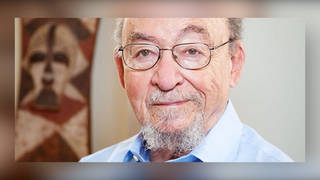
Topics
Guests
- Darius Rejaliprofessor of political science at Reed College and author of the new book, Torture and Democracy. His other books include Torture and Modernity: Self, Society and State in Modern Iran.
As the ACLU calls on Congress to appoint an independent prosecutor to investigate the Bush administration’s approval of torture, we speak with Darius Rejali, a renowned expert on the history and politics of torture. He is professor of political science at Reed College and author of a new book called Torture and Democracy. [includes rush transcript]
Transcript
AMY GOODMAN: On Capitol Hill, we hear that the congresspeople are talking about taxes. We also, today, turn to the issue of torture, an issue that has been out there now for the last few weeks. The ACLU is calling on Congress to appoint an independent prosecutor to investigate the Bush administration’s approval of torture. The call comes after President Bush admitted Friday he was aware that top administration officials had personally discussed and approved the CIA’s use of brutal interrogation techniques on suspects in the so-called “war on terror.” He told ABC News, “I’m aware our national security team met on this issue. And I approved. I don’t know what’s new about that. I’m not so sure what’s so startling about that,” he said.
Well, last week, ABC News revealed a Principals Committee on the National Security Council agreed on controversial interrogation techniques, including physical assault, sleep deprivation and waterboarding. The officials involved included Vice President Dick Cheney, then-National Security Adviser Condoleezza Rice, then-Defense Secretary Donald Rumsfeld and then-Secretary of State Colin Powell.
ACLU Executive Director Anthony Romero said, “We have always known that the CIA’s use of torture was approved from the very top levels of the US government, yet the latest revelations about knowledge from the President himself and authorization from his top advisers only confirms our worst fears.” Romero went on to say, “It is a very sad day when the President of the United States subverts the Constitution, the rule of law and American values of justice.”
Well, Darius Rejali is a renowned expert on the history and politics of torture. He’s a professor of political science at Reed College here in Oregon and author of a new book called Torture and Democracy, joining us here in Portland. Welcome to Democracy Now!
DARIUS REJALI: Good morning. It’s good to be here.
AMY GOODMAN: It was great to have you in New York. Now, these latest revelations, what is your response, Professor Rejali?
DARIUS REJALI: Well, I mean, they fall under the doctrine of command responsibility; that is to say, moral culpability lies with people who know that something is happening or should have known that something is happening under their command and had the power to stop it. So, typically under war crimes trials and things of this sort, this doctrine has been evoked quite a bit. So, first of all, on the moral side, that’s the issue.
Actually, the interesting thing for me on the political side is that it doesn’t fit any of the two models we thought were happening in the White House. One of the models was that there was this kind of — this is a more conservative argument — a slippery slope: people sent mixed messages, and then people went on to torture. And then, the other model is the Mafia model, the wink-wink, nod-nod model: just get it done, I don’t care how. It turns out, actually, that there were not only demonstrations, but also that the policymakers that were key to this wanted a legal cover. And so, they cared enough about the rule of law — this is the silver lining, if you want — that they actually went to lawyers and had them write a cover, which means that sort of on the — this is sort of central to the thesis of Torture and Democracy — when democracies torture, they always try and do it under the cover of law, and they try and do it in such a way that appears that no torture is actually happening, leaving torture techniques that leave no marks and things that really make it difficult for victims to come forward credibly.
AMY GOODMAN: Talk about that difference — it’s just an odd phrase to say “when democracies torture” — but the difference between torture in democracies and not democracies.
DARIUS REJALI: Yeah. Most people think that, well, logically, democracies are unlikely to torture, because they’re bargains of leniency — people don’t like to be tortured, they elect their rulers, rulers don’t torture them — whereas in authoritarian states, they can torture them as much as they want, because the people don’t control power.
In fact, it’s a little different than that. Authoritarian states indeed use scarring techniques, techniques — they don’t particularly care if they leave bloody marks or if journalists report or other sorts of things, because they can stop them. In democracies where there’s a minimal civil society, where people watch their government, whether they’re church groups or whether they’re newspaper organizations or human rights organizations, then whether it’s your local government, your local police or your national government, they try to use cleaner techniques. And by this, I mean techniques that leave very few marks. I mean, the list of techniques that you read earlier — sleep deprivation, various forms of stress positions, waterboarding — these are all techniques that are actually kind of rare in human history up until the nineteenth century, where we find them appearing first in democracies and then spreading —-
AMY GOODMAN: Like where?
DARIUS REJALI: Well, waterboarding -— well, let’s say electrotorture, the most famous of these, is — first appears in the United States in the 1908. Emma Goldman was — documented the very first electrotorture device in American prisons, the famous anarchist writer. 1908, she documented something called the “humming bird,” which was a device that probably hummed with electricity, which was used in New York prisons. So it’s very, very early on that we start using these things.
AMY GOODMAN: I mean, in terms of torture, you go back to slavery.
DARIUS REJALI: Yes, certainly slavery existed. What’s really interesting about slavery is that there were two types of techniques in — among slavers. There were techniques that left marks. Most people think that slavery is about whipping and those things. That mostly pertained to owners. But dealers, to sell slaves, had to leave no marks on their slaves, because that would affect the price. So what we find — what’s very interesting is that the techniques that slave dealers were using start becoming much more common, and the police start adopting them in the United States starting in the late nineteenth, early twentieth century. And they become common interrogation techniques in the ’20s and ’30s.
AMY GOODMAN: Can you talk about what happens to a society that has engaged in torture?
DARIUS REJALI: Yeah. There’s always blowback. There’s always blowback. One of the things that definitely happens is that, particularly if the torture happens in a foreign war, is that the soldiers come back, and those who have been involved in torture get involved in usually security activities, policing or private security. And what then happens is that they use the same techniques to get ahead that they did in the war.
Torture has a twenty-year shadow, it appears. That is to say, the reason we all know waterboarding, for example, isn’t because we had waterboarding from the early days; it’s because the soldiers who came back from the Philippine insurgency war in 1902 all brought it back to the United States, and then this technique started appearing all over the United States, particularly in the South and against conscientious objectors during the World War I.
So — and the same thing happened in Chicago. We have —- one of the biggest torture crises of recently years was the torture crisis in Chicago, which involved hundreds of victims and including people who were forced to confess and were condemned to death row. And -—
AMY GOODMAN: You’re talking about the police commander, Jon Burge —-
DARIUS REJALI: Jon Burge
AMY GOODMAN: —- and the prisoners forced to so-called confess, end up being taken off of death row now, and say that they were tortured —-
DARIUS REJALI: That is correct.
AMY GOODMAN: —- and now the documentation is there.
DARIUS REJALI: There are many other cases that will soon probably come into that whole discussion. The main point is that the torture techniques that were used by police in those circumstances were torture techniques that were first documented in southern Vietnam during the Vietnam War. So somebody brought these back. And so, I mean, the thing is that the torture techniques in this war are likely to appear in a neighborhood near you sometime in the next twenty years, and that’s one of the most serious blowbacks of this.
AMY GOODMAN: What about the INS, the Immigration and Naturalization Service? What happens to immigrants in detention centers?
DARIUS REJALI: Well, certainly we know that in some cases the techniques that appeared in the Iraq war —-
AMY GOODMAN: It is now known as ICE, by the way.
DARIUS REJALI: ICE?
AMY GOODMAN: Right, no longer INS -—
DARIUS REJALI: INS, I see.
AMY GOODMAN: — Immigration and Naturalization Service.
DARIUS REJALI: OK. Well, we know that the techniques that appeared in those kinds of detention centers often preceded the ones that happened in the Iraq theater. In other words, the techniques of torture, they don’t respect borders. They don’t need passports. They flow out, and they come back in. And, you know, this is one of the points I often make to people. The line between domestic and international policing is a very thin one, and that you can’t really anticipate where these things are going to show up. And INS prisons, or ICE prisons, I guess, now are less — as far as I know, they’re less regulated in some ways than —-
AMY GOODMAN: There’s also the for-profit prisons.
DARIUS REJALI: Yeah, there’s the for-profit perspective, too, absolutely. And that’s also true in the war theater. That is to say, increasingly in the future, all the wars that we are likely to engage in are going to be asymmetric wars with counterinsurgency forces, and given that we have a press and all this human rights monitoring, it’s likely that interrogation itself will be privatized and has been for some time.
Now, the positive side of this is, presumably, that if you can -— if you’re privatizing interrogation, you can also get civil liability. That is to say, that instead of trying people for criminal charges, you can get actual compensation from victims. I expect we’re going to — for victims. So I expect we’ll see many more suits against corporations saying that, well, you know, if you’re going to do this, then you need to pay up.
AMY GOODMAN: Finally, just a brief history — it’s hard to talk about the word “brief” with this monumental book, Torture and Democracy, but a brief history of torture. I remember right around the time of the invasion, at the Pentagon, Rumsfeld was telling people to watch the film The Battle of Algiers. But go back in time.
DARIUS REJALI: Well, for me, the history of torture begins with basically the amnesia that starts at the end of World War II, when we forget that our societies and democracies tortured. We tended to think of torture as something tied to the Inquisition.
But here’s basically the story. In the nineteenth century, for a variety of reasons, we were capable of controlling torture, and we actually put an end to most torture in Europe. But it didn’t stop in the colonies of states, and it didn’t stop in the more distant and other parts of our countries. In the twentieth century, after World War II, this stuff rolls back. In France, in the Battle of Algiers, famously, the French started using torture, and it was claimed to be effective. Sadly, I mean, now that we actually know the data for the Battle of Algiers, it’s a disaster, right? They issued 24,000 torture warrants for probably less than 1,400 guerrillas. In other words, they tortured about twenty innocent people for each accurate person that they got. And this is kind of normal.
Torture is actually the clumsiest method that one could possibly use — and this is not me; this is the Japanese fascist police, the Kempeitai — to gather information. It’s worse than anything else you could use. But around the Battle of Algiers, a myth developed, that you could in fact somehow use torture to make it work. And the movie The Battle of Algiers, unfortunately, kind of helped that, because it didn’t really catch the fact that most of the information the French got came from standard police files and public cooperation and informers, which is what we know normally happens with police forces. But, I mean, if you look at the movie The Battle of Algiers, you don’t see any informers in it, except for the very first part of it. So there’s a general kind of mythology about torture, that it’s somehow effective, that it worked for the Gestapo, which it didn’t any more than it worked for the French.
But somehow we think — and this is the bottom line — that democracy makes us weak and that torture makes the man. And that’s just not true. Basically, what we know is that the standard policing procedures that democracies use, which require heavy public cooperation — if you don’t have public cooperation, the chances that you’ll identify a crime or identify a guerrilla or a terrorist fall to less than ten percent. I mean, these are huge studies that show this. Torture is not going to solve that problem.
AMY GOODMAN: Darius Rejali, I want to thank you for being with us once again, but here in your hometown of Portland, Oregon. Torture and Democracy is his book. Professor Rejali teaches political science at Reed College. Thank you.
DARIUS REJALI: Nice to be here.












Media Options